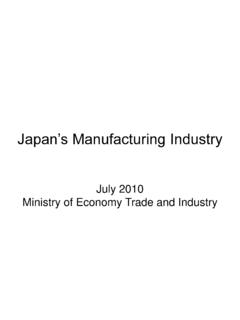Transcription of Manufacturing and Registered Apprenticeship: A Toolkit
1 AFL-CIO Working for America Instituteand ApprenticeshipUSAM anufacturing and Registered Apprenticeship: A ToolkitA Toolkit FOR Manufacturing AND Registered apprenticeship 3A Toolkit FOR Manufacturing AND Registered apprenticeship 5 Registered apprenticeship is growing in importance to the Manufacturing sector of the economy. A robust and technologically sophisticated Manufacturing industry is essential to our nation s economic success, and to our ability to raise wages and provide family-supporting jobs. Across the nation, Manufacturing jobs offer powerful economic benefits. The challenges faced by manufacturers, and their unions and workers, cannot be ignored.
2 Advanced Manufacturing companies and industrial unions face complicated workforce challenges in an increasingly competitive global marketplace. Those challenges require a skilled workforce to foster employer success and empower workers to control their career development. Registered apprenticeship can address skill shortages and skill gaps that are impeding manufacturers efforts to expand, innovate and compete in a global environment, as well as address the latest technological advances. The AFL-CIO Working for America Institute, under contract with the Department of Labor, has developed this Toolkit to assist companies, unions and other stakeholders to develop, register and implement apprenticeship programs.
3 We hope this Toolkit becomes a valuable resource for all stakeholders. It is a work in progress that will evolve as the AFL-CIO Working for America Institute gains further knowledge and experience in expanding the apprenticeship model and implementing Registered apprenticeship programs. We encourage your feedback. Whether you re a business or labor organization, an industry association or workforce intermediary partnership, a community college or the public workforce system, or a community-based organization, we invite you to use this Marschall, DirectorAFL-CIO Working for America InstituteJune 2017 INTRODUCTION: A Toolkit FORMANUFACTURING AND Registered APPRENTICESHIPA Toolkit FOR Manufacturing AND Registered apprenticeship 71.
4 Registered apprenticeship 9 A. Key Components 9 B. Partnerships 10 C. Employer Considerations 12 D.
5 Types of apprenticeship Programs 12 E. Apprentice Sponsors 13 F. Related Instruction 15 G. On-the-Job-Learning (OJL) 15 H.
6 Support for Apprentices and Diversity 162. Career Pathways in Manufacturing 173. Joint Labor-Management Partnerships 19 A. Introduction 19 B.
7 No Labor Agreement 19 C. Unionized Facility with a Collective Bargaining Agreement 194. apprenticeship Preparation and Pre- apprenticeship Programs 21 Appendices 23 Appendix A Examples of Registered apprenticeship Programs in Manufacturing 24 Appendix B Resources on Registered apprenticeship 27 Appendix C Members of the Industrial Union Council 28 Acknowledgments 29contentsA Toolkit FOR Manufacturing AND Registered apprenticeship 9 Unions and their signatory employers have a long and proud history of
8 Designing and implementing apprenticeship programs, stretching back to the decades around the Civil War. Between 60% and 70% of Registered apprentices are in labor-affiliated programs that contribute more than $ billion a year to the economy. The presence of Registered apprenticeship is most apparent in the building and construction trades, where unions and employers are engaged in more than 1,600 joint labor-management apprenticeship training committees. In the modern era, Registered apprenticeship has evolved into a complex system that encompasses more than 1,000 occupations in such diverse industries as health care, hospitality and food services, information technology and advanced Manufacturing .
9 Training is provided by thousands of state and federal apprenticeship sponsors, including joint labor-management committees. More than 400,000 apprentices participate every year in about 20,000 Registered apprenticeship programs apprenticeship is governed by standards approved by the federal government Office of apprenticeship and State apprenticeship Agencies. At its core, Registered apprenticeship has been successful because the hands-on, earn while you learn approach provides highly skilled workers and supports them with wages from a job while they learn skills and a trade that enables them to move forward on a career pathway.
10 The practice of apprenticeship is an important expression of the move toward a multiple career pathway perspective in the provision of education and skill training in the United States. When apprentices enter a Registered apprenticeship program operated by a joint labor-management committee especially if it is established and funded through a collective bargaining agreement they are engaged in a private-sector institution with an increased chance of long-term sustainability. apprenticeship programs are strongest when they are part of self-funding institutions. Registered apprenticeship that is part of a system governed by unions and employers provides tangible benefits.







